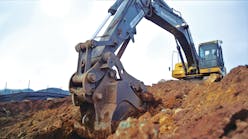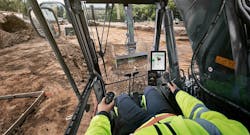There was a time when the grading and excavation contractors who bought or rented their vehicles from RoadBuilders Machinery & Supply Co. in Kansas City, KS, cared little about the telematics systems installed in them.
That’s changing. Contractors now—at least those who want to squeeze as much life as they can out of their machines while monitoring how efficiently their operators are completing their jobs—are eager to learn how to use the wireless monitoring programs that come with their graders and excavators to track idle time, how much fuel these machines have burned, and how many work hours they’ve logged.
There was a time when the grading and excavation contractors who bought or rented their vehicles from RoadBuilders Machinery & Supply Co. in Kansas City, KS, cared little about the telematics systems installed in them. That’s changing. Contractors now—at least those who want to squeeze as much life as they can out of their machines while monitoring how efficiently their operators are completing their jobs—are eager to learn how to use the wireless monitoring programs that come with their graders and excavators to track idle time, how much fuel these machines have burned, and how many work hours they’ve logged. [text_ad] Jeff McConnell, the coordinator for the KOMTRAX wireless monitoring system that now comes installed with Komatsu construction vehicles, says that this trend is only getting stronger. “I’d say it’s a surge right now, compared to the way it used to be,” says McConnell. “Our customers are learning just how important telematics can be, and how much money it can save them. So they want to learn everything they can about it.” Telematics isn’t new. Manufacturers have been installing remote monitoring software in their heavy construction equipment for more than a decade. The benefits of telematics are, or should be, well known today, too. This information is important to those contractors who want to avoid costly repairs or even more costly replacements. By monitoring how their machines have worked, contractors can schedule maintenance and repairs at the right time. This can lead to longer lifespans for graders and excavators and lower operation costs for contractors. Today’s telematics systems are more powerful, too—another enticement for those contractors who have yet to embrace this technology. Contractors can use telematics to not only monitor their machines, but also the status of their jobs. Contractors, for instance, can use remote monitoring to track how many piles of earth their graders and excavators moved in a day, and how that compares with how many they needed to move to stay on schedule on a job site. Why are contractors more likely today to rely on telematics? Not surprisingly, it comes down to the bottom line, and the challenge of running a profitable business in a competitive industry. “This trend has been driven by increasing project costs and increasing fuel costs,” says Chris Richardson, construction software manager in the Melbourne, Australia, office of Trimble, a manufacturer of telematics systems. “Contractors have always been concerned about their costs, but today, they are under more pressure to complete their jobs as efficiently as possible. Telematics systems allow contractors to complete their work in a more efficient manner. They are able to track the important activities on their projects. Because of this, we are definitely seeing an uptick in interest in this space.” This is a big change from the way contractors used telematics in the past. In the early days of this tech, contractors were limited to monitoring the activity of their vehicles. A dot on a map would show them where their vehicles were at any given point of time. An advanced system might have told them how many hours their machines spent idling versus working or charted how much fuel it burned in a given day. Today, contractors can use telematics to increase the odds that they are staying on schedule on their job sites, says Richardson. That is a powerful tool for owners who are constantly looking for ways to reduce their expenses and improve their yearly profits. “You can use telematics to track how the progress on a project is proceeding,” says Richardson. “You can use it to see how close you are to hitting specific target dates. ‘Am I actually working toward my goal in an efficient manner?’ Telematics can help you determine that. It really is changing. We are moving more and more into the project management side of the equation.” It’s little surprise, then, that as the power of telematics increases, so does the acceptance of this technology among contractors.Jeff McConnell, the coordinator for the KOMTRAX wireless monitoring system that now comes installed with Komatsu construction vehicles, says that this trend is only getting stronger.
“I’d say it’s a surge right now, compared to the way it used to be,” says McConnell. “Our customers are learning just how important telematics can be, and how much money it can save them. So they want to learn everything they can about it.”
Telematics isn’t new. Manufacturers have been installing remote monitoring software in their heavy construction equipment for more than a decade.
The benefits of telematics are, or should be, well known today, too.
This information is important to those contractors who want to avoid costly repairs or even more costly replacements. By monitoring how their machines have worked, contractors can schedule maintenance and repairs at the right time. This can lead to longer lifespans for graders and excavators and lower operation costs for contractors.
Today’s telematics systems are more powerful, too—another enticement for those contractors who have yet to embrace this technology. Contractors can use telematics to not only monitor their machines, but also the status of their jobs. Contractors, for instance, can use remote monitoring to track how many piles of earth their graders and excavators moved in a day, and how that compares with how many they needed to move to stay on schedule on a job site.
Why are contractors more likely today to rely on telematics? Not surprisingly, it comes down to the bottom line, and the challenge of running a profitable business in a competitive industry.
“This trend has been driven by increasing project costs and increasing fuel costs,” says Chris Richardson, construction software manager in the Melbourne, Australia, office of Trimble, a manufacturer of telematics systems.
“Contractors have always been concerned about their costs, but today, they are under more pressure to complete their jobs as efficiently as possible. Telematics systems allow contractors to complete their work in a more efficient manner. They are able to track the important activities on their projects. Because of this, we are definitely seeing an uptick in interest in this space.”
This is a big change from the way contractors used telematics in the past. In the early days of this tech, contractors were limited to monitoring the activity of their vehicles. A dot on a map would show them where their vehicles were at any given point of time. An advanced system might have told them how many hours their machines spent idling versus working or charted how much fuel it burned in a given day.
Today, contractors can use telematics to increase the odds that they are staying on schedule on their job sites, says Richardson. That is a powerful tool for owners who are constantly looking for ways to reduce their expenses and improve their yearly profits.
“You can use telematics to track how the progress on a project is proceeding,” says Richardson. “You can use it to see how close you are to hitting specific target dates. ‘Am I actually working toward my goal in an efficient manner?’ Telematics can help you determine that. It really is changing. We are moving more and more into the project management side of the equation.”
It’s little surprise, then, that as the power of telematics increases, so does the acceptance of this technology among contractors.










